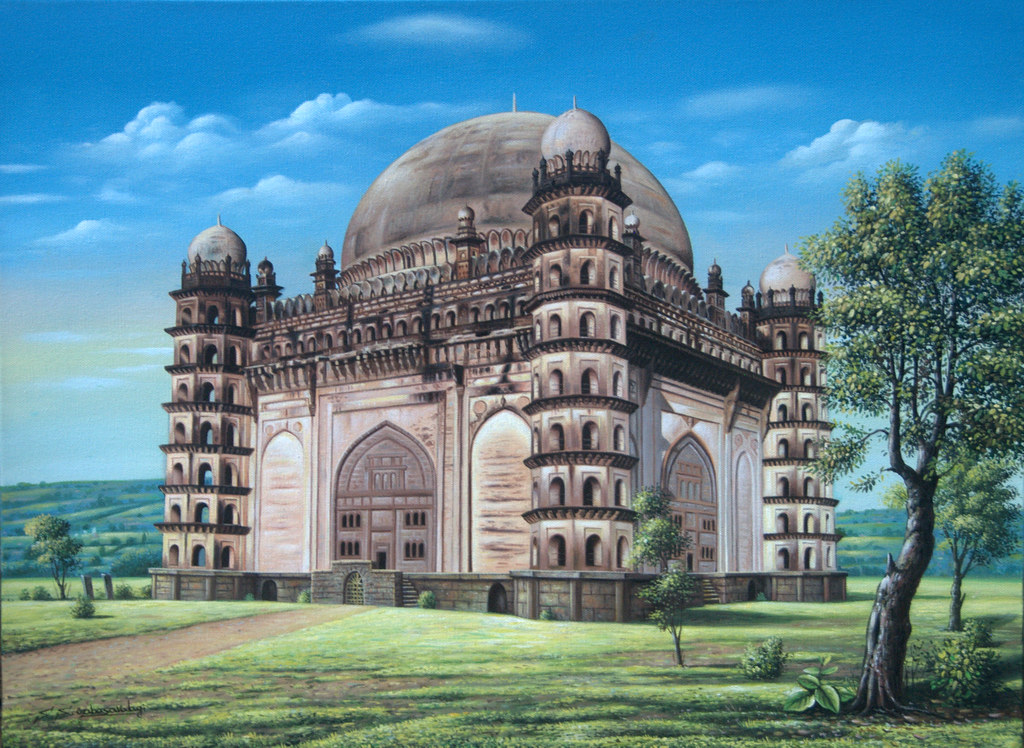Difference between revisions of "Sultanate of Bijapur"
Tao alexis (talk | contribs) |
Tao alexis (talk | contribs) |
||
| (4 intermediate revisions by the same user not shown) | |||
| Line 1: | Line 1: | ||
| − | The '''Sultanate of Bijapur''' is a Sunni Muslim | + | [[File:Sultanate of Bijapur.jpg|right|525px|thumb|the Gol Gumbaz, begun in 1626]] |
| + | The '''Sultanate of Bijapur''' is a Sunni Muslim empire of the Indian Subcontinent, reaching from the [[Western Ghats (mountains)|Western Ghats]] mountains, across the central Deccan to the [[Bay of Bengal]]. The Sultanate has access to the [[Arabian Sea]] but has no significant ports there). The great centre of Bijapur controls the sultanate; it is celebrated as a place of education and learning, medical arts, music and architecture; envoys, merchants and travellers visit the city to observe its magnanimity and grandeur. The empire is, however, lies on the precipice of decline; though peace exists between Bijapur and the Moghuls, Vijayanagar in the south has made threatening moves to seize back some of the empire it has lost, while the Moghuls may be ready to strike from the north. | ||
The Sultanate covers an area of 288 [[20-mile Hex Map|hexes]] and has a population of 3,225,341. It borders on the [[Empire of the Moghuls|Moghul Empire]] ([[Sultanate of Ahmadnagar|Ahmadnagar]], [[Subahdar of Berar|Berar]] and [[Subahdar of Bodhan|Bodhan]]); [[Kingdom of Golconda|Golconda]] ([[Subahdar of Hyderabad|Hyderabad]] and [[Subahdar of Helipuri|Helipuri]]); [[Empire of Vijayanagar|Vijayanagar]] ([[Nayak of Madurai|Madurai]], [[Kingdom of Mysore|Mysore]], [[Nayak of Keladi|Keladi]] and [[Nayak of Manjarun|Manjarun]]); and the European colonies of [[Colony of Goa|Goa]] and [[Colony of Coromandel|Coromandel]]. | The Sultanate covers an area of 288 [[20-mile Hex Map|hexes]] and has a population of 3,225,341. It borders on the [[Empire of the Moghuls|Moghul Empire]] ([[Sultanate of Ahmadnagar|Ahmadnagar]], [[Subahdar of Berar|Berar]] and [[Subahdar of Bodhan|Bodhan]]); [[Kingdom of Golconda|Golconda]] ([[Subahdar of Hyderabad|Hyderabad]] and [[Subahdar of Helipuri|Helipuri]]); [[Empire of Vijayanagar|Vijayanagar]] ([[Nayak of Madurai|Madurai]], [[Kingdom of Mysore|Mysore]], [[Nayak of Keladi|Keladi]] and [[Nayak of Manjarun|Manjarun]]); and the European colonies of [[Colony of Goa|Goa]] and [[Colony of Coromandel|Coromandel]]. | ||
| Line 6: | Line 7: | ||
== Geography == | == Geography == | ||
| + | The region overlies that part of the Western Ghats called the Sahyadri mountain, with its foothills on the east; the mountains slope into the Arabian Sea on the west. Ridges of the Ghats reach eastward to where they meet the Deccan Plateau, a rocky terrain marked by boulders and somewhat inconsistent terrain. This stretches across the Sultanate from east to west until reaching the Nallamala Hills, a part of the [[Eastern Ghats (mountains)|Eastern Ghats]]. The Penner river, rising in the Deccan, flowing through the hills to drain into the Bay of Bengal. The Coromandel Coast is a strip of lowland with extensive mangrove forest and river deltas. | ||
| + | |||
| + | == History == | ||
| + | Following the Bahmani decline in 1518, when that Sultanate collapsed, a former Georgian slave and adventurer named Yusuf Adil Shah, having become the Governor of Bijapur, used his power to establish himself as an independent sultan. A brilliant commander, Yusuf established a dynasty; progressively over the next century his sons and grandsons would vastly expand the power and wealth of Bijapur at the expense of Vijiyanagar and others. The present ruler, Mohammed Adil, the seventh in the dynasty, signed a treaty with the Moghuls that ended expansion of Bijapur in the north. | ||
| + | |||
| + | [[Category: Political Divisions of the World]][[Category: Don't Review until 2023]] | ||
Latest revision as of 02:41, 6 June 2022
The Sultanate of Bijapur is a Sunni Muslim empire of the Indian Subcontinent, reaching from the Western Ghats mountains, across the central Deccan to the Bay of Bengal. The Sultanate has access to the Arabian Sea but has no significant ports there). The great centre of Bijapur controls the sultanate; it is celebrated as a place of education and learning, medical arts, music and architecture; envoys, merchants and travellers visit the city to observe its magnanimity and grandeur. The empire is, however, lies on the precipice of decline; though peace exists between Bijapur and the Moghuls, Vijayanagar in the south has made threatening moves to seize back some of the empire it has lost, while the Moghuls may be ready to strike from the north.
The Sultanate covers an area of 288 hexes and has a population of 3,225,341. It borders on the Moghul Empire (Ahmadnagar, Berar and Bodhan); Golconda (Hyderabad and Helipuri); Vijayanagar (Madurai, Mysore, Keladi and Manjarun); and the European colonies of Goa and Coromandel.
The Sultanate is divided into six subahdars (Belgaum, Bellary, Bijapur, Kolhapur, Nellore and Pondicherry) and one Nayak (Vandavasi).
Geography
The region overlies that part of the Western Ghats called the Sahyadri mountain, with its foothills on the east; the mountains slope into the Arabian Sea on the west. Ridges of the Ghats reach eastward to where they meet the Deccan Plateau, a rocky terrain marked by boulders and somewhat inconsistent terrain. This stretches across the Sultanate from east to west until reaching the Nallamala Hills, a part of the Eastern Ghats. The Penner river, rising in the Deccan, flowing through the hills to drain into the Bay of Bengal. The Coromandel Coast is a strip of lowland with extensive mangrove forest and river deltas.
History
Following the Bahmani decline in 1518, when that Sultanate collapsed, a former Georgian slave and adventurer named Yusuf Adil Shah, having become the Governor of Bijapur, used his power to establish himself as an independent sultan. A brilliant commander, Yusuf established a dynasty; progressively over the next century his sons and grandsons would vastly expand the power and wealth of Bijapur at the expense of Vijiyanagar and others. The present ruler, Mohammed Adil, the seventh in the dynasty, signed a treaty with the Moghuls that ended expansion of Bijapur in the north.
